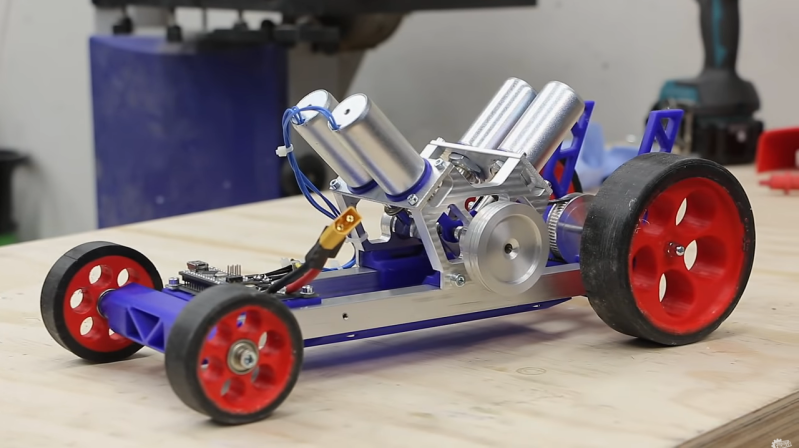[Emiel] aka [The Practical Engineer] makes all kinds of fun projects in his fully-featured shop, and one of his tangents has been building a series of solenoid engines. These engines mimic the function of an internal combustion engine, with each solenoid acting as a piston. The only problem with [Emiel]’s concept engines, though, was that he never actually put them into a vehicle to prove their effectiveness. This build finally proves that they can work at powering a vehicle.
The project starts with a new engine. [Emiel] chose a V4 design using four solenoids and an Arduino-based controller. After some trouble getting it to operate properly, he scavenged a small circuit board he built in his V8 solenoid engine to help with timing. With that installed, the solenoids click away and spin the crankshaft at a single constant speed. The vehicle itself was mostly 3D printed, with two aluminum tubes as support structures to mount the engine. Even the wheels were 3D printed with a special rubber coating applied to them. With a small drive train assembled, it’s off to the races for this tiny prototype.
While the small car doesn’t have steering and only goes at a constant speed, the proof of concept that these tiny electric engines actually work is a welcomed addition to [Emiel]’s collection of videos on these curious engines. Of course they’re not as efficient as driving the wheels directly with an electric motor, but we all know there’s no fun in that. If you haven’t seen his most intricate build, the V8 is certainly worth checking out, and also shows off the timing circuitry he repurposed for this car.















Cool project
And for more Rube Goldberg have the drive shaft driven by a hydraulic motor with solenoids on the other end.
It needs a reduction gear. Can’t get any power out without increasing the engine speed.
Sure you can. If this motor had 6 coils instead of 4, youd be looking at a mechanically complicated, standard bldc motor. Engine speed is a function of Voltage and switching speed between coils. Power is a function of current. Current maxed out? rewire your coils with thicker wire.
And standard bldc motor controllers could power it using variable pulses for speed control
From the same engine, no you can’t because you’re limited by how much current the solenoids will handle before overheating.
Power is a function of torque x speed, and you’re maxed out on torque because you’re maxed out on current, so the only way to get more power is to make it switch faster, which means you need a greater reduction to the gears. Right now it’s like trying to take off on fifth gear.
Truthful engineering and good videography makes for happy build porn anytime.
I’d love to see a full size solenoid motor replacing a gasoline internal combustion engine in a car.
i would like to see how german tüv is watching if you try to get it street certified
it could be much better if he only had replaced de usual steel rod with a neodymium magnet, used a ticker wire in the coils , and the drive circuit was an h bridge so the circuit could change the coil´s polarity atracting an repeling the magnet in a syncronous way. it could be 100% more powerful !!!
Look at “Slider Solenoids” used in organ building (as in pipe organs). They’re technically two solenoids and a rod through the middle in a single package, but because of that they allow you to shift them back and forth in both directions.
And they’re not skimpy on the power either, when they’re 36V@5A and some are like 16Kg of force.
how about winding the solenoid coils with 2 wires each,bifilar, and high magnetic connecting the end of the first wire with the start of the second wire?